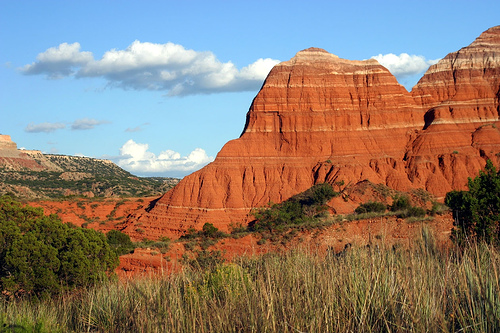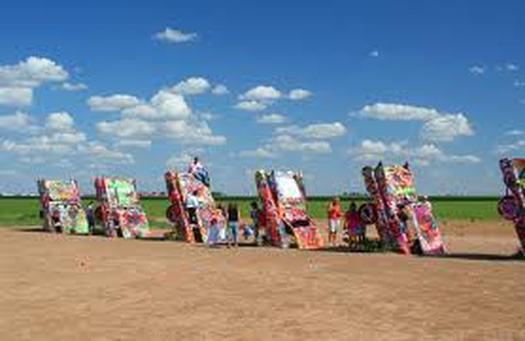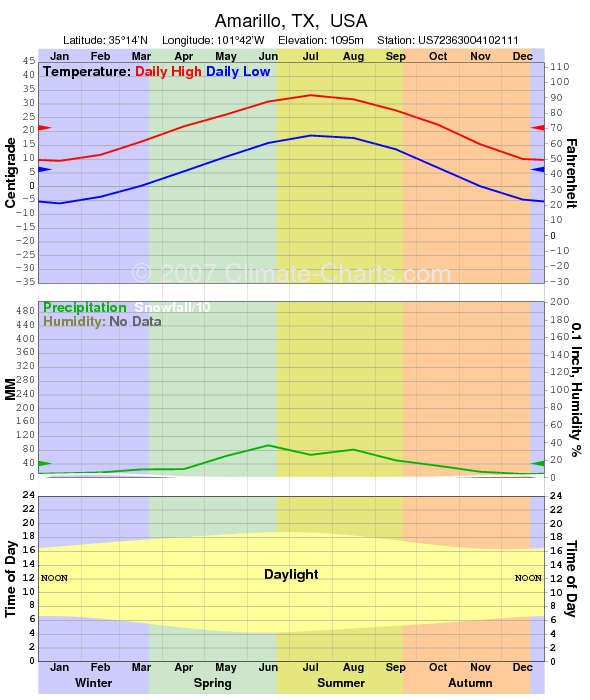Landscape
Amarillo is located near the middle of the Texas Panhandle and is part of the Llano Estacado or Staked Plains region which has a surface that is relatively flat and has little drainage in the soil. Due to the lack of developed drainage, much of the rainfall either evaporates, infiltrates into the ground, or accumulates inplaya lakes. According to the United States Census Bureau, the city has a total area of 90.3 square miles (234 km2), with 89.9 sq mi (233 km2) of it land and 0.4 sq mi (1.0 km2) of it (0.50%) water. The Amarillo metropolitan area is the 180th-largest in the United States with a population of 236,113 in four counties: Armstrong, Carson, Potter, and Randall.
About 20 miles (32 km) northeast of Amarillo is the Canadian River, which divides the southern part of the High Plains to form the Llano Estacado. The river is dammed to form Lake Meredith, a major source of drinking water in the Texas Panhandle region. The city is situated near the Panhandle Field, in a productive gas and oil area, covering 200,000 acres (800 km2) in Hartley, Potter, Moore, Hutchinson, Carson, Gray, Wheeler, and Collingsworth counties. The Potter County portion had the nation's largest natural gas reserve. Approximately 25 miles (40 km) south of Amarillo is the canyon system, Palo Duro Canyon.
The underground structures known as Amarillo Mountains are an extension of the Arbuckles of Oklahoma and the Ouachita of Arkansas and Oklahoma. They are some thousands of feet underground. The range was discovered by pioneer oilmen. Some of the peaks are believed to be 10,000 feet (3,000 m) high.[21] The tallest peak is reported to be 2,500 feet underground in northeast Potter County under the Alibates National Monument.
population and culture
Amarillo has a number of natural attractions near the city. The Palo Duro Canyon State Park is the United States' second largest canyon system, after the Grand Canyon and is located south of Amarillo. Palo Duro has a distinct hoodoo that resembles a lighthouse. Another natural landmark near the city, the Alibates Flint Quarries National Monument is located 30 miles (50 km) north of Amarillo. It is once known as the site for prehistoric inhabitants to obtain flint in order to make tools and weapons. About 100 miles (160 km) southeast of Amarillo in Briscoe County is Caprock Canyons State Park and Trailway, the state park is the home of the official Texas State Bison Herd, who were captured and taken care of by cattle rancher Charles Goodnight.
From 1932 to 1977, the Paramount Theater, originally built for $250,000, flourished in Amarillo. It had plush red carpet, murals and a pipe organ, 1,433 seats, and was considered the finest theater north of Dallas. The building is now an office and parking garage.
Local millionaire Stanley Marsh 3 has funded many public art projects in the city including the Cadillac Ranch, located west of Amarillo on Interstate 40, a monument of painted Cadillac automobiles that were dug into the ground head first. Marsh participates as well in an ongoing art project called the Dynamite Museum, which consist of thousands of mock traffic signs. These signs, bearing messages such as "Road does not end" or displaying a random picture, are scattered throughout the city of Amarillo. Besides these works, one can find close to the city the final earthwork of Robert Smithson (and another commission by Marsh), Amarillo Ramp.
The city has events and attractions honoring the cowboy and Texas culture. During the third week of September, the Tri-State Fair & Rodeo brings participants mostly from Oklahoma, New Mexico and Texas to Amarillo since 1921. On the Tri-State Exposition grounds, the Amarillo National Center is a special events center for events ranging from national equestrian competitions to motor sports and rodeos. The World Championship Ranch Rodeo sponsored by the Working Ranch Cowboys Association is held every November in the Amarillo Civic Center. Amarillo hosts the annual World Championship Chuckwagon Roundup the first weekend in June. Teams in competition prepare a feast of breaded beef cutlets, mashed potatoes, baked beans, and sourdough biscuits and attempt to duplicate the food served on western cattle trails of the 1860s and 1870s. The Amarillo Livestock Auction on Bull Rd. holds a free-to-the-public cattle auction on Tuesdays. Now located on Interstate 40, The Big Texan Steak Ranch is famous by offering visitors a free 72 ounce (2 kg) beef steak if it (and its accompanying dinner) is eaten in under an hour.
climate
Amarillo and the Texas Panhandle's climate is semi-arid (Köppen climate classification BSk). It is characterized by a rush of cold air from the north or northwest into a warmer area and occasionally, by blizzards during the winter season and a hot summer with low humidity. The normal annual precipitation is 19.7 inches (500 mm), most of it occurring in the late spring and summer months. Average daily high temperatures range from 48 °F (9 °C) in January to 92 °F (33 °C) in July. Sunny weather prevails year-round, with nearly 3300 hours of bright sunshine annually. The National Weather Service in Amarillo forecasts and provides climatic data for the city.
Extremes range from -16 to 111 °F (-27 to 44 °C), in February 1899 and June 2011, respectively, but lows below 0 °F (−18 °C) do not occur every year (1.7 nights), while highs above 100 °F (38 °C) are seen on 5.2 days.[33] Blizzards are very possible, but snowfall is typically light, averaging nearly 18 inches (46 cm) seasonally and the median figure is near 10 inches (25 cm).[33] Amarillo and the Texas Panhandle are situated on the western portion of "Tornado Alley".[34] Amarillo is also recorded as the third windiest city in the U.S, behind Blue Hill Observatory, Massachusetts and Dodge City, Kansas
http://www.50thahs.org/history2.htm



